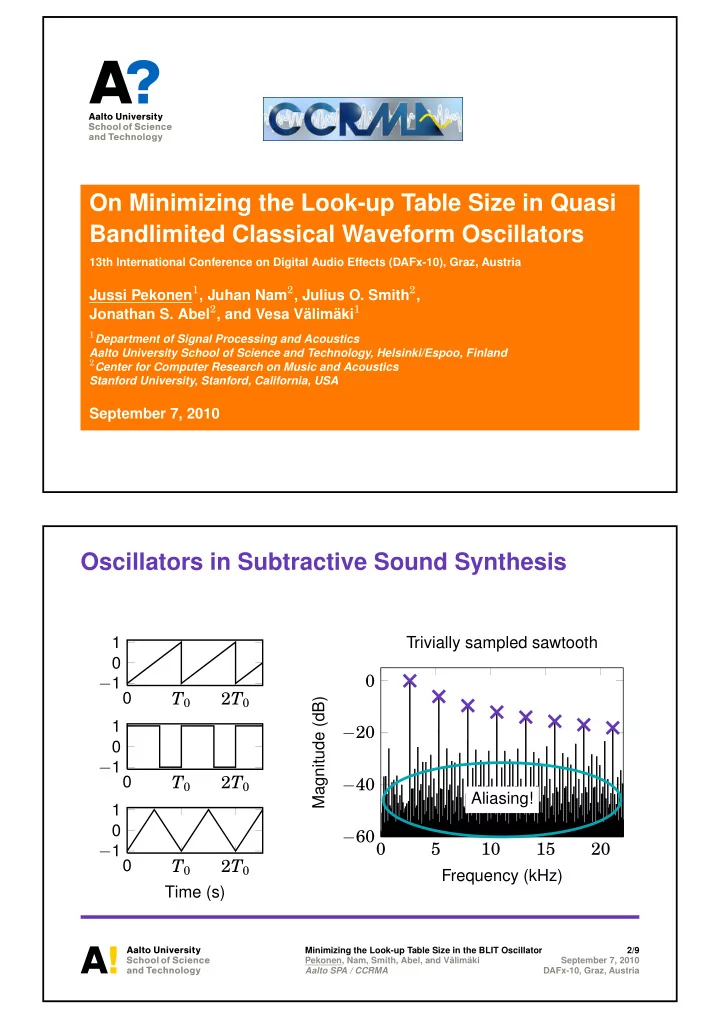

On Minimizing the Look-up Table Size in Quasi Bandlimited Classical Waveform Oscillators 13th International Conference on Digital Audio Effects (DAFx-10), Graz, Austria Jussi Pekonen 1 , Juhan Nam 2 , Julius O. Smith 2 , Jonathan S. Abel 2 , and Vesa Välimäki 1 1 Department of Signal Processing and Acoustics Aalto University School of Science and Technology, Helsinki/Espoo, Finland 2 Center for Computer Research on Music and Acoustics Stanford University, Stanford, California, USA September 7, 2010 Oscillators in Subtractive Sound Synthesis 1 Trivially sampled sawtooth 0 0 − 1 0 T 0 2 T 0 Magnitude (dB) 1 − 20 0 − 1 0 T 0 2 T 0 − 40 Aliasing! 1 0 − 60 0 5 10 15 20 − 1 0 T 0 2 T 0 Frequency (kHz) Time (s) Minimizing the Look-up Table Size in the BLIT Oscillator 2/9 Pekonen, Nam, Smith, Abel, and Välimäki September 7, 2010 Aalto SPA / CCRMA DAFx-10, Graz, Austria
Bandlimited Impulse Train (BLIT) Algorithm Continuous-Time Derivation 1 2 f 0 0 2 f 0 − 1 d d t − 1 2 f 0 − 2 0 T 0 2 T 0 0 T 0 2 T 0 Bandlimited impulse trains (Stilson and Smith, 1996) H lp ( ω ) ⇒ Ideally a sequence of sinc functions! 1 2 f 0 0 2 f 0 − 1 � − 1 2 f 0 − 2 0 T 0 2 T 0 0 T 0 2 T 0 Time (s) Time (s) Minimizing the Look-up Table Size in the BLIT Oscillator 3/9 Pekonen, Nam, Smith, Abel, and Välimäki September 7, 2010 Aalto SPA / CCRMA DAFx-10, Graz, Austria Problems in the BLIT Algorithm sinc function infinitely long! ⇒ Truncation, windowing & tabulation High oversampling required in order to get proper positioning For good quality, long tables are required Short Table Example (Hann-Windowed sinc Function) 1 0 Magnitude (dB) Level 0 . 5 − 50 Play 0 − 100 0 10 20 30 0 5 10 15 20 Table index Frequency (kHz) Minimizing the Look-up Table Size in the BLIT Oscillator 4/9 Pekonen, Nam, Smith, Abel, and Välimäki September 7, 2010 Aalto SPA / CCRMA DAFx-10, Graz, Austria
Means to Improve the Performance? Replace the windowed sinc function BLIT using sinc with the plain window function? Magn. (dB) 0 Optimize: minimize table size while keeping aliasing inaudible and − 50 amplitude drop acceptable Play − 100 0 5 10 15 20 0 BLIT using Hann window Magn. (dB) sinc Magn. (dB) 0 Hann − 50 − 50 Play − 100 − 100 0 0 . 5 1 2 3 4 0 5 10 15 20 Frequency ( × f s ) Frequency (kHz) Minimizing the Look-up Table Size in the BLIT Oscillator 5/9 Pekonen, Nam, Smith, Abel, and Välimäki September 7, 2010 Aalto SPA / CCRMA DAFx-10, Graz, Austria Parametric Window Functions Approach 1: Kaiser & Dolph-Chebyshev Windows Allow control over the minimum stopband attenuation! Gain depends on the table parameters First-order IIR post-EQ filter to compensate the amplitude drop Example: Kaiser Window 0 Magnitude (dB) 4 samples, 110 dB 4 samples, 220 dB − 50 8 samples, 110 dB − 100 − 150 0 0 . 5 1 1 . 5 2 2 . 5 3 3 . 5 4 Frequency ( × f s ) Minimizing the Look-up Table Size in the BLIT Oscillator 6/9 Pekonen, Nam, Smith, Abel, and Välimäki September 7, 2010 Aalto SPA / CCRMA DAFx-10, Graz, Austria
Direct Optimization Strategies Approach 2: Minimax & Least-Squared Minimized Stopband Gain Objective Minimize the stopband gain using an error measure Subject to Passband gain constraints Design Issues Error measure: minimax, least-squares, other? Weighted error: how to choose the frequency dependency? 0 Magnitude (dB) LS, no weight MM, no weight − 50 LS, with weight − 100 − 150 0 0 . 5 1 1 . 5 2 2 . 5 3 3 . 5 4 Frequency ( × f s ) Minimizing the Look-up Table Size in the BLIT Oscillator 7/9 Pekonen, Nam, Smith, Abel, and Välimäki September 7, 2010 Aalto SPA / CCRMA DAFx-10, Graz, Austria Conclusions Aliasing in BLIT algorithm investigated using short look-up tables The ideal windowed sinc function is not the optimal look-up table! Better alias reduction performance with alternative approaches Like fractional delay filters (Nam et al., 2010) In this paper 1. Parametric window functions Gain depends on parameters Amplitude compensation using post-EQ 2. Direct optimization approaches Minimize a weighted error measure in stopband Independent control over the amplitude drop Minimizing the Look-up Table Size in the BLIT Oscillator 8/9 Pekonen, Nam, Smith, Abel, and Välimäki September 7, 2010 Aalto SPA / CCRMA DAFx-10, Graz, Austria
Further Pointers Aside This Paper. . . J. Nam, V. Välimäki, J. S. Abel, and J. O. Smith. Efficient antialiasing oscillator algorithms using low-order fractional delay filters. IEEE Transactions on Audio, Speech, and Language Processing , 18(4): 773–785, May 2010. T. S. Stilson and J. O. Smith. Alias-free digital synthesis of classic analog waveforms. In Proceedings of the International Computer Music Conference , pages 332–335, Hong Kong, China, August 1996. Additional Material @ Companion Page Look-up tables presented in the paper Sound examples URL: http://www.acoustics.hut.fi/go/dafx10-optosctables/ Minimizing the Look-up Table Size in the BLIT Oscillator 9/9 Pekonen, Nam, Smith, Abel, and Välimäki September 7, 2010 Aalto SPA / CCRMA DAFx-10, Graz, Austria
Recommend
More recommend